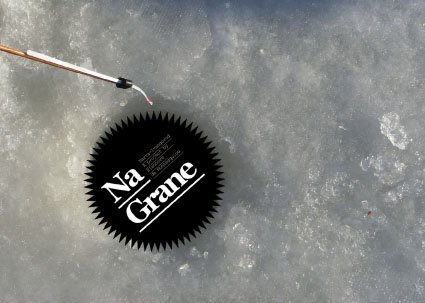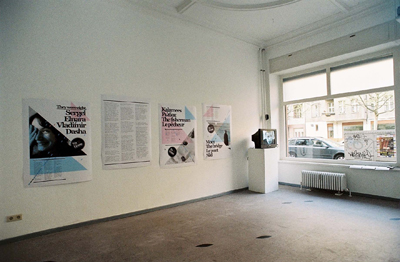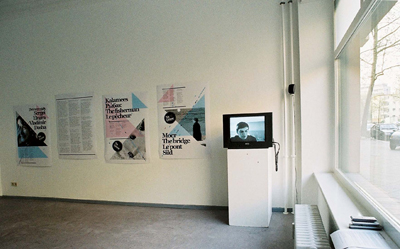Eléonore de Montesquiou – Na Grane

*** German version below ***
Opening Thursday, April 23, 2009, 7 p.m.
Finissage Sunday, June 28, 2009, 7p.m., Screening
Duration April 24 – June 28, 2009
Videoart at Midnight #6
Friday, May 22, 2009, 12 p.m.
Kino Babylon, Rosa-Luxemburg-Str. 30, 10178 Berlin
Eléonore de Montesquiou’s (* in Paris, France, lives and works in Berlin) exhibition Na Grane is the frist in a series of exhibitions on the symmetries and asymmetries between contemporary migration and tourism, taking place at uqbar project space 2009-2010 within the frame of the interdisciplinary project Transient Spaces - The Tourist Syndrome.
Since February 2007 Eléonore de Montesquiou collects images and interviews in Narva and Ivangorod, cities located on both sides of the Estonian-Russian border. Na Grane (On the Border) draws a multilayered portrait of the living and working condition in the border region at the very edge of Europe, and of the inhabitants, being in between times and spaces. The exhibition, consisting of films, posters, photos and drawings, continues the artist’s work and investigations about current transformation processes in a post-socialist Estonia.
The film Kalamees (sound: Tatjana Kozlova) takes a central place in the exhibition: during 30 minutes we follow Sasha, going out with other fisherman on the frozen lakes and rivers, making holes in the ice, and staying all day long in the cold, waiting for the fish. While fishing, Sasha talks about his life. He grew up in Ivangorod, in an apartment in the highest building of the city, overlooking the river, the bridge, in a word the border. Today Sasha is in his late twenties, he lives in Ivangorod, works in the Kreenholm factory in Narva, goes out at night in St. Petersburg, criss-crossing the Russian-Estonian border daily, not speaking a word of Estonian. The individual portrait raises questions of what it means to live right on a border, in particular, the border between Russia and Estonia, the external border of the European Union and the Schengen area, a border which did not exist when Sasha was born, now defining nearly all area’s of his life.
The film There Were Eight presents additional views of the situation. Dasha, Elnara, Sergej and Danis, who were eight years old during Perestroika, talk about their memories of the end of the Soviet Union, and how they perceive the changes. Did the changes broaden their teenage world at the time? What are the limits today?
Exhibition view
On May 22, 2009, 12 p.m., Eléonore de Montesquiou presents the videos Most (2009, 8’), Kalamees (2009, 30’), and Kreenholm (2009, 30’, first release) from the Na Grane complex in frame of the series Videoart at Midnight at Kino Babylon, Rosa-Luxemburg-Str. 30, 10178 Berlin.
On June 28, 2009, 7 p.m., on the occasion of the finissage of her exhbition Na Grane, Eléonore de Montesquiou presents the videos Keel (2009, 13', sound: Liis Kürgens) by Eléonore de Montesquiou, Kreenholm (2009, 25', sound: Marcel Türkowsky) by Eléonore de Montesquiou, Redio Siti (2008, 4'30") by Elise Florenty and Red Flag (2002-03, 3') by Olga Kisseleva.
The exhibition is funded with support from the European Commission and the Insitut Français.
 |
Eröffnung Donnerstag, 23. April 2009, 19:00 Uhr
Finissage Sonntag, 28. Juni 2009, 19:00 Uhr, Screening
Laufzeit 24. April – 28. Juni 2009
Videoart at Midnight #6
Freitag, 22. Mai 2009, 24:00 Uhr
Kino Babylon, Rosa-Luxemburg-Str. 30, 10178 Berlin
Die Ausstellung Na Grane der Künstlerin Eléonore de Montesquiou (* in Paris, Frankreich, lebt und arbeitet in Berlin) ist der Auftakt zu einer Ausstellungsreihe über die Symmetrien und Asymmetrien zwischen Migration und Tourismus heute, die der Projektraum uqbar 2009-2010 im Rahmen des interdisziplinären Projekts Transient Spaces - The Tourist Syndrome präsentiert.
Seit Februar 2007 sammelt Eléonore de Montesquiou Bilder und Interviews in den Städten Narva und Ivangorod an der estnisch-russischen Grenze. Na Grane (An der Grenze) entwirft ein vielschichtiges Portrait der Lebens- und Arbeitsbedingungen in der Region an der europäischen Außengrenze, und der Bewohner, in Zeiten und Räumen des Übergangs. Die Ausstellung, die aus Filmen, Postern, Fotos, und Zeichnungen besteht, setzt in gewisser Weise frühere Arbeiten und Untersuchungen der Künstlerin zu aktuellen Transformationsprozessen im post-sozialistischen Estland fort.
Zentrales Element der Ausstellung ist der Film Kalamees (Ton: Tatjana Kozlova): 30 Minuten lang folgen wir Sasha, der mit den anderen Fischern auf die zugefrorenen Seen und Flüsse loszieht, Löcher ins Eis stößt, und den ganzen Tag lang in der Kälte darauf wartet, dass Fische anbeißen. Beim Angeln erzählt er aus seinem Leben: Aufgewachsen in Ivangorod, in einer Wohnung im höchsten Gebäude der Stadt, mit Blick auf den Fluss, die Brücke, das heißt auf die Grenze, lebt Sasha heute, mit Ende Zwanzig, noch immer in Ivangorod, arbeitet in der Kreenholm Fabrik in Narva und geht abends in St. Petersburg aus. Er passiert die russisch-estnische Grenze täglich, ohne ein Wort Estnisch zu sprechen. Das sehr persönliche Porträt wirft Fragen auf nach dem, was es bedeutet, direkt an der Grenze zu leben, insbesondere der Grenze zwischen Russland und Estland, der Außengrenze der Europäischen Union und des Schengen Raums, einer Grenze, die nicht existierte, als Sasha geboren wurde, und nun nahezu alle Bereiche seines Lebens bestimmt.
Der Film They Were Eight stellt weitere Perpektiven auf die Problematik vor. Dasha, Elnara, Sergej und Danis, die während der Perestroika acht Jahre alt waren, reden über ihre Erinnerungen an das Ende der Sowjetunion, und darüber wie sie die Veränderungen erfahren. Haben die damaligen Veränderungen ihre Teenager-Welt erweitert? Wie nehmen sie heute die Grenzsituation wahr?
Ausstellungsansicht
Am 22. Mai 2009 präsentiert Eléonore de Montesquiou die Videos Most (2009, 8'), Kalamees (2009, 30') und Kreenholm (2009, 30', Uraufführung) aus dem Na Grane Komplex im Rahmen der Reihe Videokunst at Midnight um 24 Uhr im Kino Babylon, Rosa-Luxemburg-Str. 30, 10178 Berlin.
Am 28. Juni 2009, 19 Uhr, präsentiert Eléonore de Montesquiou zur Finissage ihrer Ausstellung Na Grane die Videoarbeiten Keel (2009, 13', Sound: Liis Kürgens) von Eléonore de Montesquiou, Kreenholm (2009, 25', Sound: Marcel Türkowsky) von Eléonore de Montesquiou, Redio Siti (2008, 4'30") von Elise Florenty und Red Flag (2002-03, 3') von Olga Kisseleva.
Die Ausstellung wird finanziert mit freundlicher Unterstützung der Europäischen Kommission und des Institut Français.
 |
Exhibition view | Ausstellungsansicht


